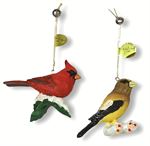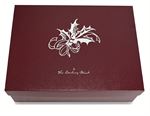×
Bidding has ended on this item.
This Auction Uses Proxy Bidding.
Lot # N286
12 Songbird Christmas Ornaments from the Danbury Mint View Watchlist >
Ended
- Winning Bid: $49.00
- 24 Bid(s) View Bid History
- High Bidder: ted
Payment Options
Seller Accepts Credit Cards
Payment and pickup instructions will be available on your invoice (under "My Account") at the conclusion of this auction.
Lot # N286
System ID # 19497043
Start Date
End Date
2 Watching
Description
12 Songbird Christmas Ornaments from the Danbury Mint
- (12) Birds
- With Collection Box
- Documentation Card For Each Bird
- Each Has Gold Hanging Ring With Official Danbury Mint Tag
Cardinal
- Abundant across the eastern and southern United States.
- The male sings in a loud, clear whistle from the top of a tree or another high location to defend his territory.
- Diet consists mainly of seeds, grains, and fruit.
- The cardinal is so popular it has been named the official bird of seven U.S. states and is the mascot for numerous sports teams.
Evening Grosbeak
- Has a large, powerful bill that allows it to crack open cherry pits.
- Male is bright yellow with a brown head and a white patch on its wings, while the female is olive-brown.
- Migrates unpredictably during the winter.
- Females usually lay 3 to 4 light blue eggs with brown markings.
Painted Bunting
- Male is bright blue, green, and red, while the female is bright greenish yellow.
- Inhabits brushy, hedges, and woodlands.
- Males are territorial and may become aggressive toward other males.
- Nests are deep, woven cups of grass, weeds, and plant fibers.
Robin
- Lives throughout North America from Alaska to Mexico.
- Named the state bird of Connecticut, Michigan, and Wisconsin.
- One of the first North American bird species to lay eggs each season.
- Diet consists of invertebrates (such as beetles, grubs, and caterpillars), fruits, and berries.
Chickadee
- Among the most vocal of all birds, calling continuously in most situations.
- Diet consists of seeds and insects.
- Hole-nesting birds, typically in trees.
- Lay anywhere from thirteen to nineteen speckled white eggs.
- Named the state bird of both Maine and Massachusetts.
Bluebird
- Prefers open grassland with scattered trees and are cavity nesters.
- Produces between two and four broods during the spring and summer.
- One of the few thrush genera in the Americas.
- Males attract female mates by singing and flapping wings, then placing nesting material in a nesting box or cavity.
Blue Jay
- Highly curious and very intelligent birds.
- Have strong black bills used for cracking nuts and acorns.
- Diet consists of corn, grains, seeds, and insects.
- Are found from southern Canada through the eastern and central United States, south to Florida and northeastern Texas.
Downy Woodpecker
- The smallest woodpecker in North America.
- Diet consists of mainly insects, seeds, and berries.
- Breeding habitat is forested areas across most of North and Central America.
- In the summer, these woodpeckers pick the surface of tree bark, and in the winter, they dig deeper to reach insects that primarily make up their diet.
Goldfinch
- A granivore adapted for the consumption of seedheads, with a conical beak to remove the seeds while feeding.
- These social birds gather in large flocks while feeding and migrating.
- Prefer open country where weeds thrive, such as fields, meadows, and edges of forests.
- The state bird of Iowa, New Jersey, and Washington.
Song Sparrow
- Favorite habitat is brushy areas and marshes across most of Canada and the United States.
- Typically learns their songs from other birds in neighboring territories.
- Has numerous subspecies with a variety of regional differences.
Rose-breasted Grosbeak
- After nesting in open woodlands in the northern U.S.A., the birds fly as far as Venezuela and Peru during the colder months.
- During incubation of the eggs, the male accounts for about a third of the day, while the female hatches the eggs the other two-thirds (including overnight).
- The beautiful sound of their singing has often been said to resemble that of a robin that’s had singing lessons.
Baltimore Oriole
- The colors of the male resemble the coat-of-arms of Lord Baltimore, for which it is named.
- Males are often recognized by their loud flutey whistle.
- Forage for insects, nectar, and berries in trees and shrubs.
- Migrate in flocks to Mexico, Central America, and northern portions of South America.
Condition:
Good, No Damage, Chips or Wear
Size:
12 Birds
3" X 2 1/2" X 2 1/2"
















